Clean water is undoubtedly a human right, yet at present the right to access such a thing grows less and less each year. With humans, wildlife and flora entirely dependent on the health and hygiene of this natural resource, water pollution continues to threaten the environment with disease and decay due to neglect, inaction and illegal human activity.
With 75% of the UK’s rivers considered unsafe to swim in, if the level of pollution continues at the same rate as now, all species on land and sea will live to see the irreversible long-term health effects of consuming and contacting unclean water and see entire ecosystems on the brink of collapse.
Now is the time to take action. By identifying the sources of water pollution we can begin to make long-overdue changes and improve the quality of our waterways. Ranging from easy-to-spot, colourful characteristics, to more covert forms that require a little investigation, here are a number of pollutants that can be identified and reported in the hope to return our waters to a healthy standard.
Download Our Handy PDF GuideDifferent types of water pollution
Agricultural Run-off
Agricultural run-off occurs when farmland soil becomes water-logged, causing the excess waters to change course and merge with nearby rivers, lakes, or streams. Weather conditions such as flooding, melted snow and rain carry a number of toxic agricultural chemicals to the water, resulting in contamination and reducing the overall quality of the water source.
The consequence of agricultural runoff leads to increased groundwater pollution as large puddles of stagnant water are soaked up by the ground soil. The overuse of agricultural chemicals, nitrates, pesticides and other non-organic compounds create a hostile marine environment and lead to a number of water-borne diseases that threaten the health of any being that comes into contact with it.
Yet, the largest threat of this pollutant is the risk of agricultural sewage - such as manure lagoons, septic tanks, and sewage on farmland - contaminating the water. As water floods these areas and looks to merge with other natural sources, it carries away with it a high amount of untreated animal sewage, creating a number of potential health-risks and infections if it later flows into drinking water sources.
Identifying Agricultural Run-off Water Pollution
As agricultural run-off is the result of natural weather fronts, this form of pollution is categorised as a ‘nonpoint source pollution’, meaning there is no way to trace it back to a single source such as a pipe or specific pollutant.
Yet, identifying agricultural run-off is fairly simple as it can only occur in flooded or water-clogged farmland. Here are some easy tell-tale signs that this is occurring.
- The area you live or are passing by has farmland that is visibly flooded.
- Farmland dredges have been created or expanded. This is where trench-like paths are dug around the farmland to encourage better water flow around the area.
- Consistent heavy rain in farmland area causing small streams of water to appear in the fields
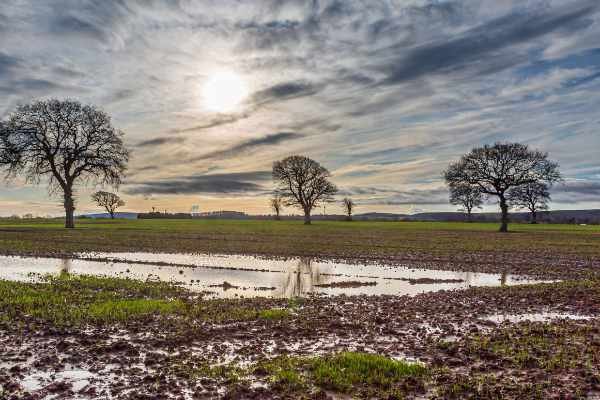
Chemical Pollution
Chemical water pollution is the presence of toxic chemicals and harmful compounds that infiltrate natural bodies of water. Although this is by far one of the more serious forms of water pollution, the difficulty is that it’s the most ambiguous, with many chemicals having no specific characteristic, odour, or source-point of pollution.
Chemical plants, factories, farms, and industrial areas legally or illegally dump harmful pollutants and heavy metals into nearby waters, severely disrupting the natural habitats of marine life and its surrounding environment. If these contaminated waters are then consumed by humans or wildlife, it results not only in sickness and disease, but can interfere with the pH of the water and create an inhospitable aquatic environment.
One of the largest risks posed by chemical pollution is the presence of PFAS chemicals, better known as “forever chemicals”. Forever chemicals are found in plastics and non-organic items that seep harmful substances into the water. If the body is in contact with these harmful substances over a prolonged period of time (such as being present in drinking water), the body can no longer expel these chemicals from our system, resulting in a series of illnesses, disease, and long-term health issues.
Identifying Chemical Water Pollution
Identifying chemical pollution may not be as straight-forward as other water pollutants, but there are some obvious signs of ‘chemical dumping’ or discarding of chemicals that are clear indicators of polluted water.
- Pipes that appear to discharge non-natural looking liquids can signal that a nearby factory or plant is releasing harmful chemicals into the water.
- Chemical smell as you approach the water - do not proceed further
- Oily or metalic looking surface film
- Chemical barrels washed up, floating in water or close to riverbank
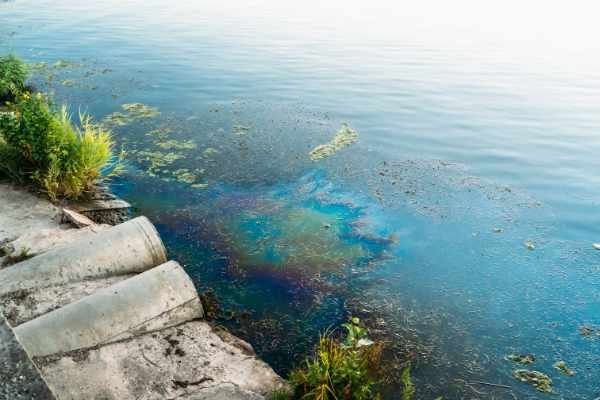
Sewage Pollution
Untreated sewage is one of the most wide-spread forms of water pollution. This happens for a number of reasons, from poor legislations and lack of responsibility on the half of governments and sewage treatment plants, to illegal sewage dumping in large industrial areas or local communities.
Sewage makes its way to water via numerous paths, the most common being the installation of land-to-water pipes that directly discharge sewage in the water. Sewage Overflows (a system designed to stop sewage plants flooding during heavy rain), also contributes when events such as flooding causes sewage and other non-biodegradable items to merge with rain water and run-off to natural bodies of water.
When water becomes contaminated with sewage, it isn’t only our health that’s at risk. The impact it has on wildlife and the surrounding environment can be deadly, with aquatic ecosystems at risk of collapsing from poor quality water, water-borne disease, and lack of biodiversity due to low oxygen levels.
Identifying Sewage Water Pollution
Amongst the different types of water pollutants, spotting sewage pollution is relatively straight forward, but to be sure that it’s sewage pollution it’s best to identify:
- Sewage pipes discharging raw sewage directly into the water (this is easily identified by the odour and appearance)
- Non-biodegradable items that are commonly flushed down the toilet such as wet wipes, sanitary products, and certain plastics.
- Visible sewage in water or strong odour of sewage when close to a natural water source.
- Milky appearance to the water with visible scum, foam or bubbles on the surface.
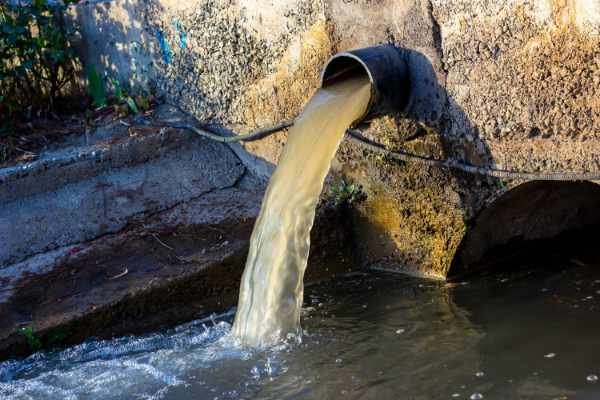
Sewage Fungus
Sewage fungus is a naturally occuring ‘polymicrobial biofilm’ that causes a fungi-like substance to populate surface waters. Formed as a direct result of discharging untreated sewage into rivers, streams or lakes, the ecological impact of this pollutant threatens not only human health, but threatens the long-term health of the aquatic ecosystem.
The reasons behind this fungus’ harmful environmental impact is due to its extremely toxic composition. Sewage fungus can only pollute low-oxygen waters, further reducing the natural oxygen demand in the water, creating an inhospitable environment for all aquatic organisms. Consisting of heavy metals and harmful bacteria, the fungus also deteriorates the water's natural chemical balance.
The presence of the fungus also impacts the water's self-cleaning system and natural flow of marine animals as it produces a number of non-organic toxins that cannot support aquatic life. Characterised by a fungus-like appearance sat afloat the water, it also contributes to surface water pollution extending its toxins to insects and land animals.
Identifying Sewage Fungus
Sewage fungus can be easily identified due to its distinct colour and appearance. Categorised as a ‘bioindicator’ of already polluted waters, the presence of this fungus is a tell-tale sign of a severe disturbance to marine life. Ranging in both colour and appearance, here are the three main characteristics of this pollutant.
- Thin, white/grey, mucus-like film on the surface of the water or coating the bed of the waterway
- Jelly-like mass, grey/brown, found in slow moving waters
- Thick, yellow/orange, cotton wool/foam-like substance afloat the water's surface
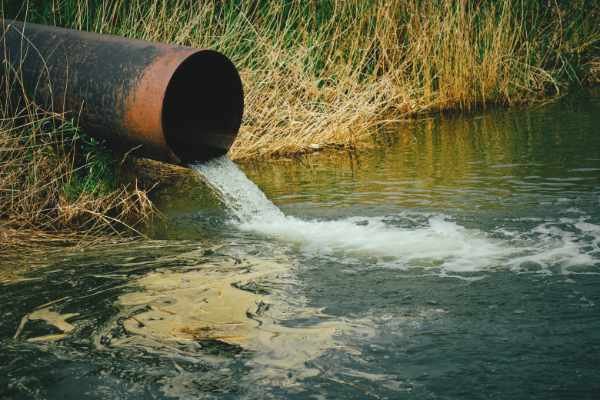
Silt
Unlike some previous pollutants mentioned in this list, silt is a naturally occurring, organic compound found in nearly all bodies of water around the globe. However, heavy agricultural practices, sewage waste, and other man-made activities have exponentially increased the amount of silt entering waterways, resulting in unlivable aquatic conditions and threatening to wipe-out certain species.
Silt is a mixture of both silt and clay particles between 0.002-0.05mm that naturally accompanies the water downstream and contributes to the natural landscape. The issues arise when heavy agricultural practices increase such as dredging (where materials are excavated from a water environment), and the dumping of ‘sewage sludge’ cause large disturbances to the fine-grain soils on the riverbed, causing the water and silt to mix and resulting in a mud-brown stream.
As silt slowly but surely grows in size, freshwater fish and benthic species such as shrimp, mussels and coral can be ‘choked’ due to oxygen depletion caused by silt. Water quality also suffers as the natural biosphere becomes hostile, killing or seriously harming other aquatic organisms and disrupting the food chain as the silt renders the water inhabitable.
Identifying Silt Water Pollution
Silt pollution varies only in size, so it’s fairly simple to identify. Here are the main characteristics of silt-polluted water.
- A large brown cloud-like area moving down the waterway
- The body of water has been completely engulfed by the silt, creating a muddy-brown river or stream.
- Individual silt-polluted rivers or streams running off into larger bodies of water, creating a contrast of muddy brown and ‘sea blue’ between the silt water and freshwater.
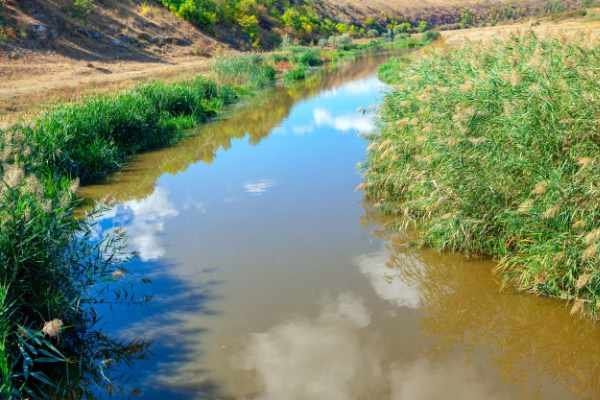
Mine Water
Industrial mining requires large amounts of water, whether it be filling a mine with water after being decommissioned, or working with water whilst drilling to obtain rocks and/or minerals. The industrial waste from mines runs to natural water sources and contaminates them with a number of harmful acids and non-organic chemicals that result in disease and deterioration of marine life and infect water supplies.
The real danger is that mine water is oversaturated with a number of heavy metals like iron, that when consumed by humans can potentially cause stomach problems, diabetes and even impotence. These heavy metals also cause marine pollution, where aquatic plants, and marine wildlife are at risk of infection and disease as their environment deteriorates.
Other harmful compounds such as sulphuric acid are created during the mining process where streams of water and acidic rock carry away the acid to natural water sources. This naturally corrosive acid then makes its way downstream where it oxidises and eats away at the natural landscape, killing organisms needed to maintain the natural flow of the environment.
Identifying Mine Water Pollution
The threat of mine water pollution mostly depends on the maintenance and safe practice of the mines themselves. Due to the variety of toxicants that contaminate the water, identifying mine polluted water focuses on three main characteristics:
- Bright or dull shade of red/yellow/orange, loss of transparency in water due to density of metals and minerals in water.
- Appearance of water filled with paint-like liquid
- Rotten egg smell near body of water (may be other pollution types too)
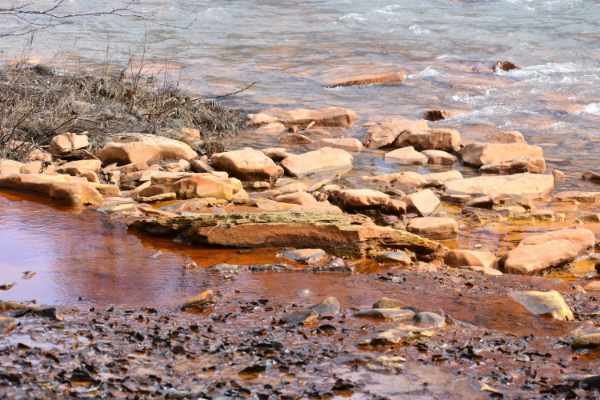
Livestock
The livestock industry is notably one industry that contributes to various forms of pollution, from the release of large amounts of air polluting methane, to the discharge of billions of tonnes of animal manure per year that infect nearby waters, the call for safer, more hygienic agricultural practices is more essential now than ever.
Livestock water pollution occurs when poor, outdated or lack of appropriate manure storage creates an overflow of manure sewage. If livestock manure is not contained correctly and it merges with bodies of water, it will travel downstream towards rivers, reservoirs and other bodies of water and leave a trail of toxic chemicals and disease in its path.
Agricultural chemical pollutants like fertilisers, hormones and pesticides also harm nearby waters when flooding, improper irrigation, or ground soil infect nearby streams and rivers, resulting in a number of health concerns, such as hormonal imbalances, skin irritation and nausea.
Identifying Livestock Water Pollution
Livestock water pollution can be identified in a number of ways depending on the source of the pollution itself. Natural events such as farmland floods can carry a number of harmful chemicals with it making it less simple to determine, however, more common issues like poor manure storage seeping into water can be easy to spot. Things to look out for include:
- Flooding of farmland in areas of high in livestock such as cows, sheep, chickens and pigs.
- Visible manure nearby to waters edge or travelling in water.
- Livestock allowed to roam into the waterway.
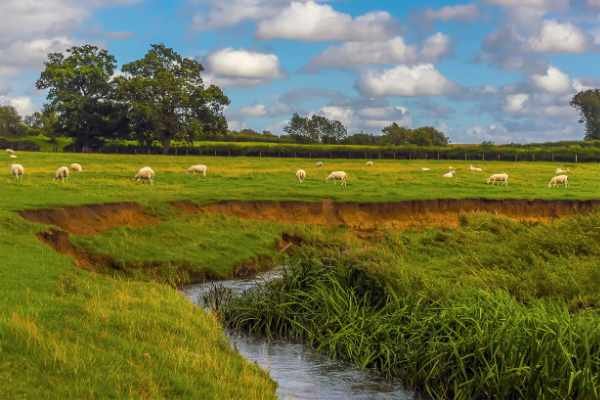
Algae
The presence of Algae is not an immediate indicator of water pollution due to its bioorganic nature. Algae is made up of a variety of naturally occuring bacteria and plants that bloom under certain water conditions. This makes algae more of a natural indicator of the quality of the water rather than a pollutant itself.
The growing issue with algae is that it multiplies at an enormous rate in the presence of certain compounds, such as Nitrogen and Phosphorus. When waters become overwhelmed with algae it interferes with the ecosystems biological oxygen demand as it converts oxygen into harmful gases. Though low-oxygen water is not the only negative impact of algae, as it also harbours some life-threatening bacteria known to cause neurological issues and even death.
Products such as laundry detergent, fertilisers and a number of heavy metals found in industrial activities indirectly manipulate the pH levels of the water and encourage the rapid growth of Algae. As the algae multiplies, essential nutrients are stripped from the water threatening the lives of marine species as organisms can no longer access the vital nutrients needed to survive.
Identifying Algae Water Pollution
As mentioned above, Algae is a naturally occurring substance that serves to clean the water it resides in. However, and over-abundance of algae create inhospitable conditions to marine life and drastically lower the water quality. Here are a number of characteristics of algal blooms that indicate poor water health and a risk to the natural environment.
- Green, blue, red, or brown water
- Appearance of foamy or scum-like substance floating on water's surface.
- Paint-like substance covering a large span of water
- Smaller or closed-off bodies of water entirely discoloured with aforementioned colours
- Visible algal blooms (appearance similar to weeds) overly-abundant in river, stream or lake.
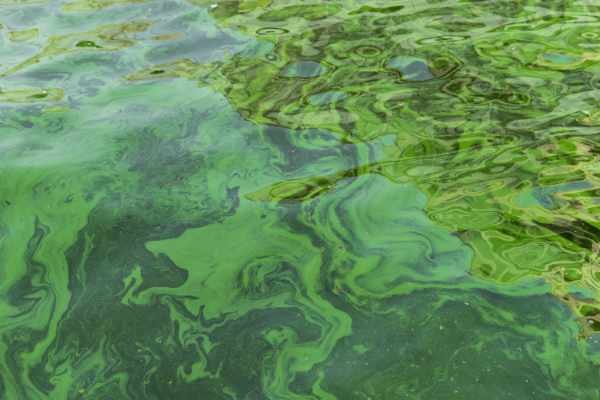
Litter & Fly Tipping
Fly tipping is the illegal dumping or disregard of waste in unauthorised areas. Large quantities of waste such as plastic, general waste or large electrical goods are deposited on the side of the road, in agricultural areas or any non-waste deposit location.
Fly tipping nearby or in water poses a larger threat not only to aquaculture, but to the overall quality and health of the environment. Microplastics, chemicals from non-consumable items such as cleaning supplies, and larger more toxic items like tyres infiltrate nearby drinking water and soil and cause an array of health-issues such as respiratory infections, eye infections and digestive issues.
Other health issues include an increase of mosquitos in areas where waste items contain stagnant water or completely block the water's natural flow. Mosquitos are known to carry a number of harmful diseases which threaten human health, but amphibians and fish also, risking the overall health of the environment and increasing the risk of life-threatening illnesses.
Identifying Litter & Fly Tipping Pollution
Efforts to combat fly tipping typically require a ‘see it, say it’ action in order to prevent it from recurring and give landowners the chance to take action. Whether it be obvious signs of fly-tipping on the side of the road, or the remains of previous dumping such as washed up waste in rivers and streams, it’s vital to identify and report the following to help preserve the ever-decreasing quality of water.
- Large amounts of household/industrial waste on the side of the road or fields.
- Non-organic items (plastic/appliances) found on riverbank or floating down stream/river.
- Chemical drums found near riverbank or nearby to water
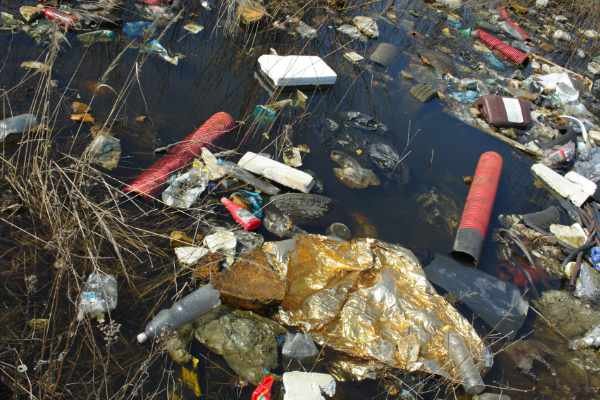
Seen Any of the Above? Report Now
Use Pollution Watch UK to report water pollution events in any water source.
Download Our Handy PDF Guide